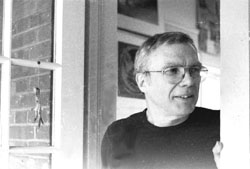

The Master of the Silkscreen
BY CHRISTINA MORGAN
Hunter-Young Professor of Studio Art John Pearson has been a member
of Oberlin’s Art Department since 1972. Pearson was born in Yorkshire,
England, trained at the Royal Academy Schools in London and received
his M.F.A. from Northern Illinois University. He has recently published
a book Silkscreen: The Poster Project, chronicling 28 years of student
silkscreen posters. Arts editor Christina Morgan sat down with Pearson
to discuss silkscreening and other artsy topics.
 (photo by Pauline Shapiro) |
Christina Morgan: You taught at Novia
Scotia College of Art and Design, the University of New Mexico and were
the International Artist in Residence at the Cleveland Institute of
Art before coming to Oberlin. How did you end up teaching here?
John Pearson: Very simple. Being English, and not knowing a great deal
about American colleges, I had never heard of Oberlin. Another artist,
Sol LeWitt, was invited to the Cleveland Institute of Art to meet with
students.
The faculty here heard he was coming, and asked him to give a talk to
Oberlin, and my wife and I drove him to Oberlin, and as we were driving
in, my wife –– we had two young kids at the time — exclaimed that she
wanted to live here. Two Oberlin art professors were going on sabbatical
in consecutive years and the College called and asked if I wanted to
teach a course, and I said ‘okay.’
CM: You have taught the class ARTS 053: “Visual Concepts and Process:
Silkscreen” at Oberlin since 1972. Students in this class learn much
more than just the silkscreening process. What is it about this class
that you think makes it so popular?
JP: Students investigate their own ideas in the class; I don’t impose
mine. My goal is to bring out their own creativity. The nice thing about
silkscreen is you can print on any canvas, the process can be built
into wallpaper, photography, etc. I’m also very demanding, I really
push them. I think Oberlin students respect that.
CM: I understand that you are very well versed in painting and sculpture.
What began your involvement with silkscreen?
JP: I was doing very large paintings and doings some drawings for the
campus, and it was very tedious. An artist friend of mine suggested
using silkscreen and it was a disaster at first. I hated it.
Then after six months of working with it started to work well, and it
sped up the process. I really took cues from Andy Warhol in terms of
the technical process, but not in themes.
CM: You have held over 90 one-man shows throughout your career in everywhere
from Japan to Croatia. Is there one show that sticks out in our mind
as being particularly important or memorable?
JP: I think probably one remembers the highlights. When I was quite
young, 23, I held a show in the Institute of Contemporary Art in London,
a very progressive space. That led to some important exhibitions in
Germany. But I tend to think of the latest work as the most important,
because I’m closest to it.
CM: In the book you published, Silkscreen: The Poster Project, you had
to choose from years and years of student-created silkscreen posters.
How did you choose which ones to include in the book?
JP: I don’t keep a formal archive. Over the years posters students left
lying around I kept in a drawer for students to look at them for examples.
I have 250 posters and simply chose 100 posters that showed different
approaches to design over the different periods of time. And because
last semester the students produced a good number of posters, six were
included.
CM: Do you have a favorite poster in the book?
JP: No, I don’t really. To me, they’re all equally fascinating and interesting
and they reflect the different personalities of the students.
CM: How do you see silkscreening at Oberlin changing in the coming years?
JP: Every semester, there are different students with different ideas.
In the late ’70s the emphasis was on race and gender issues.
Each generation brings a different set of cultural values, whatever
happens in the culture is going to create the change and I can’t predict
the future.
![]()
Students Bring Quartett's Sinister Eroticism to Life
New Student Poetry Group Opens for Alix Olson
FAVA Show Has Promise, but Comes Up Short